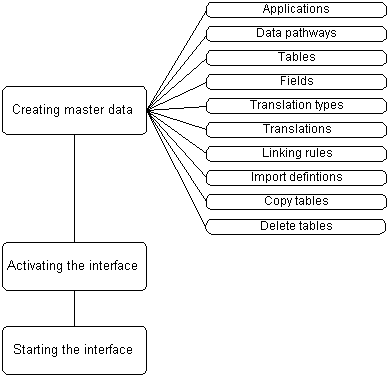Connectivity Manual - EDIS - Setting up an interface
Setting up an interface
Flowchart

Applications
In [EDIS: Master data, Maintenance, Applications], applications can be created. You can give the applications a name of your choice, for example "RELAPACK" for a relation package.
Data pathways
The transfer of this application to EXACT is defined in [EDIS: Master data, Maintenance, Data pathways]. The application 'EXACT' is predefined. You can activate the link to enable the actual transfer during the processing of data.
Tables
The data to be transferred needs to be identified. Per type of data to be transferred, table names should be defined in [EDIS: Master data, Maintenance, Tables].
Fields
Per record-type to be transferred, the record layout needs to be defined. This record layout is created as details of the table. A field in a record layout can have several formats:
- Character: character fields can contain characters as well as digits;
- Integer: an integer is a whole number (not a fractional number) that can be positive, negative, or zero;
- Date: internally always YYYYMMDD. When importing, the date format can be converted from ymd, dmy, mdy to this internal format - this depends on the 'date format';
- Logical: internally always 1 (for yes) or 0 (for no). When importing Y(es), T(rue), 1, J(a) all evaluate to true, N(o), F(alse), 0 all evalute to false;
- Decimal: a decimal is a digit with decimals. If you select decimal, you can also enter the number of decimals you want to use. Mind that the length you enter includes the number of decimals. So when the length is 15, and the number of decimals is 2, the format is 12 digits before the decimal separator, the decimal separator (depends on numeric format) (also part of the field length) and 2 digits behind the decimal separator. If this field is filled with a negative amount, the minus is also part of the field length.

Translation types and translations
If necessary, translation types can be defined in [EDIS: Master data, Maintenance, Translation types] . This can be necessary when the format of a field in the Exact Financials database differs from the format in the other database. For example, the debtor code in the Exact Financials database can only consist of digits and the debtor code in the other database consists of digits and characters. This needs to be converted in the EDIS database. An other example is that Exact Financials does not understand the value of certain fields of the third application. When, for example the payment method in the third application is bank, the value in the Exact Financials database is 2, so a translation rule should be created for this. See [Example]. The actual translations can be created in [EDIS: Master data, Maintenance, Translations].
Link rules
In [
EDIS: Master data, Maintenance, Link rules] the actual links to the fields in the external application and Exact can be defined.
- Select the input application and table.
- Select the application to go to and a sequence number. This functionality can be used, for example when you use a customer relation application as external application and you want your customers to be imported as debtors and creditors in the Exact Financials database. This can be done in one session using this functionality.
- You can also assign a constant or an expression (formula) to a field. For the formula, a mentor is available to guide you through the process. This functionality can be used to divide headers and lines of for example financial entries.
It is also possible to write data from one table in the "third application" to two or more tables in Exact Financials. This can, for example be useful if the "third application" is a relation package. You may want to import your relation in both the debtor and creditor tables of Exact Financials. In that case you can create two or more link rules for one table of the "third application". It is also possible to add a condition to the link rule, here you can for example indicate that every relation with customer type 1 has to be imported in the creditor table. See [Example].
Connectivity Manual >
Contents >
EDIS >
Setting up an interface
| Main Category: |
Support Product Know How |
Document Type: |
Support - On-line help |
| Category: |
On-line help files |
Security level: |
All - 0 |
| Sub category: |
General |
Document ID: |
18.326.552 |
| Assortment: |
Exact Financials
|
Date: |
29-01-2009 |
| Release: |
|
Attachment: |
|
| Disclaimer |